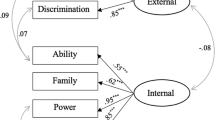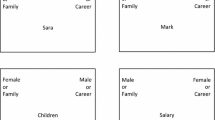Abstract
The changing dynamics of gender stereotypes and the effect of context in adults are two aspects that have been confirmed in the literature. Less research has been carried out with adolescents however. This paper analyzes gender stereotypes and self-attributions in Spanish adolescents using positive and negative gender-typed attributes of GRI-JUG. Study 1 evaluated attributes in terms of valence, desirability and typicality. In Study 2, the structure of the attributes was explored in order to identify a new measure of gender typing. In Study 3, the self-attributions of adolescents were examined. The results showed a broad agreement between boys and girls in relation to the valence of attributes. With regard to desirability and typicality, an effect of both participant gender and target gender was found. The confirmatory factor analysis identified four dimensions in the new measure. While positive attributes were related to the masculine and feminine dimensions, negative ones were better described in terms of passive and active dimensions. Finally, boys, but not girls, used negative attributes for self-description. Together, these findings suggest that gender stereotypes and self-attributions are changing in adolescents. Furthermore, our results can be considered to be an empirical confirmation of the rupture of the masculinity-male and femininity-female associations.


Similar content being viewed by others
References
Alicke, M. D., Guenter, C. L., & Zell, E. (2012). Social self-analysis: Constructing and maintaining personal identity. In M. R. Leary & J. P. Tangney (Eds.), Handbook of self and identity (2nd ed., pp. 291–308). New York: Guilford.
Alvariñas, M., Fernández, M. A., & López, C. (2009). Actividad física y percepciones sobre deporte y género. Revista de Investigación en Educación, 6, 113–122.
Amezcua, J. A., & Pichardo, M. C. (2000). Teenagers’ gender differences in self-concept. Anales de Psicología, 16, 207–2014.
Athenstaedt, U. (2003). On the content and structure of the gender role self-concept: Including gender-stereotypical behaviors in addition to traits. Psychology of Women Quarterly, 27, 309–318. https://doi.org/10.1111/pwqu.2003.27.issue-4.
Bem, S. L. (1974). The measurement of psychological androgyny. Journal of Consulting and Clinical Psychology, 42(2), 155–162. https://doi.org/10.1037/h0036215.
Berger, A., & Krahé, B. (2013). Negative attributes are gendered too: Conceptualizing and measuring positive and negative facets of sex-role identity. European Journal of Social Psychology, 43, 516–531. https://doi.org/10.1002/ejsp.1970.
Biernat, M., Vescio, T. K., & Green, M. L. (1996). Selective self-stereotyping. Journal of Personality and Social Psychology, 71, 1194–1209.
Blakemore, J., Berenbaum, S. A., & Liben, L. S. (2009). Gender development. New York: Psychology Press.
Boletín oficial de Estado [Official State Bulletin] (2004). Medidas de protección integral contra la violencia de género [Integral protection measures against gender violence][Law 1/2004].
Boletín oficial del Estado [Official State Bulletin] (2007). Ley para la igualdad efectiva de mujeres y hombres [Law for effective equality of women and men] [Law 3/2007].
Bosak, J., Eagly, A., Diekman, A., & Sczesny, S. (2017). Women and men of the past, present, and future: Evidence of dynamic gender stereotypes in Ghana. Journal of Cross-Cultural Psychology, 49(1), 115–129. https://doi.org/10.1177/0022022117738750.
Bosson, J. K., & Michniewicz, K. S. (2013). Gender dichotomization at the level of ingroup identity: What it is, and why men use it more than women. Journal of Personality and Social Psychology, 105, 425–442. https://doi.org/10.1037/a0033126.
Brislin, R. W. (1970). Back-translation for cross-cultural research. Journal of Cross-Cultural Psychology, 1(3), 185–216. https://doi.org/10.1177/13591045700010030.
Castillo-Mayén, M. R., & Montes-Berges, B. (2014). Analysis of current gender stereotypes. Anales de Psicología, 30(3), 1044–1060. https://doi.org/10.6018/analesps.30.3.138981.
Colás, P., & Villaciervos, P. (2007). La interiorización de los estereotipos de género en jóvenes y adolescentes. Revista de Investigación Educativa, 25(1), 35–58.
Connell, R. W. (2003). Masculinidades. PUEG-UNAM: Mexico.
Croft, A., Schmader, T., & Block, K. (2015). An underexamined inequality: Cultural and psychological barriers to men’s engagement with communal roles. Personality and Social Psychology Review, 9(4), 343–370. https://doi.org/10.1177/1088868314564789.
Crouter, A. C., Whiteman, S. D., McHale, S. M., & Osgood, D. W. (2007). Development of gender attitude traditionality across middle childhood and adolescence. Child Development., 78(3), 911–926. https://doi.org/10.1111/j.1467-8624.2007.01040.x.
Diekman, A. B., & Eagly, A. H. (2000). Stereotypes as dynamic constructs: Women and men of the past, present, and future. Personality and Social Psychology Bulletin, 26, 1171–1188. https://doi.org/10.1177/0146167200262001.
Diekman, A. B., Eagly, A. H., Mladinic, A., & Ferreira, M. C. (2005). Dynamic stereotypes about women and men in Latin America and the United States. Journal of Cross-Cultural Psychology, 36(2), 209–226. https://doi.org/10.1177/0022022104272902.
Donnelly, K., & Twenge, J. M. (2017). Masculine and feminine traits on the Bem sex-role inventory, 1993–2012: A cross-temporal meta-analysis. Sex Roles, 4(1–10), 556–565. https://doi.org/10.1007/s11199-016-0625-y.
Egan, S. K., & Perry, D. G. (2001). Gender identity: A multidimensional analysis with implications for psychosocial adjustment. Developmental Psychology, 37(4), 451–463. https://doi.org/10.1037//0012-I649.37.4.45I.
Elmelech, Y., & Lu, H. (2004). Race, ethnicity; and the gender poverty gap. Social Science Research, 33(1), 158–182. https://doi.org/10.1026/S0049-089X(03)00044-9.
Fernández, J., & Coello, M. T. (2010). Do the BSRI and PAQ really measure masculinity and femininity? The Spanish Journal of Psychology, 13, 1000–1009.
García-Retamero, R., Müller, S. M., & López-Zafra, E. (2011). The malleability of gender stereotypes: Influence of population size of perceptions of men and women in the past, present, and future. The Journal of Social Psychology, 151(5), 635–656. https://doi.org/10.1080/00224545.2010.522616.
García-Vega, E., Menéndez, E., García, P., & Rico, R. (2010). Influence of the sex and gender in the sexual behavior of adolescents. Psicothema, 22(4), 606–612.
Glick, P., Lameiras, M., Fiske, S. T., Eckes, T., Masser, B., Volpato, C., et al. (2004). Bad but bold: Ambivalent attitudes toward men predict gender ineguality in 16 nations. Journal of Personality and Social Psychology, 86, 713–728. https://doi.org/10.1037/0022-3514.86.5.713.
Hondagneu-Sotelo, P. (2003). Gender and U.S. Immigration: Contemporary Trends. California: University of California Press.
Islam, K. M. M., & Asadullah, M. N. (2018). Gender stereotypes and education: A comparative content analysis of Malaysian, Indonesian, Pakistani and Bangladeshi school textbooks. PLoS One, 13(1), e0190807. https://doi.org/10.1371/journal.pone.0190807.
John, N. A., Stoebenau, K., Ritter, S., Edmeades, J., & Balvin, N. (2017). Gender socialization during adolescence in low- and middle-income countries: Conceptualization, influences and outcomes. New York: Unicef.
Jost, J. T., & Kay, A. C. (2005). Exposure to benevolent sexism and complementary gender stereotypes: Consequences for specific and diffuse forms of system justification. Journal Personality and Social Psychology, 88(3), 498–509. https://doi.org/10.1037/0022-3514.88.3.498.
Kelly, J. A., Caudill, M. S., Hathorn, S., & O’Brien, C. G. (1977). Socially undesirable sex-correlated characteristics: Implications for androgyny and adjustment. Journal of Consulting and Clinical Psychology, 45, 1185–1186.
Kerkhoven, A. H., Russo, P., Land-Zandstra, A. M., Saxena, A., & Rodenburg, F. J. (2016). Gender stereotypes in science education resources: A visual content analysis. PLoS One, 11(11), e0165037. https://doi.org/10.1371/journal.pone.0165037.
Krahé, B., Berger, A., & Möller, I. (2007). Entwicklung und Validierung eines Inventars zur Erfassung der Geschlechtsrollenorientierung im Jugendaler. Zeitschrift für Sozialpsychologie, 38, 195–208.
Liben, L. S., & Bigler, R. S. (2002). The developmental course of gender differentiation: Conceptualizing, measuring, and evaluating constructs and pathways. Monographs of the Society for Research in Child Development, 67(2), 1–147. https://doi.org/10.1111/1540-5834.t01-1-00187.
López-Zafra, E., & García-Retamero, R. (2012). Do gender stereotypes change? The dynamic of gender stereotypes in Spain. Journal of Gender Studies, 21(2), 169–183. https://doi.org/10.1080/09589236.2012.661580.
López-Zafra, E., García-Retamero, R., Diekman, A., & Eagly, A. H. (2008). Dynamics of gender stereotypes and power: A cross-cultural study. Revista de Psicología Social, 23(2), 213–219. https://doi.org/10.1174/021347408784135788.
Manea, C. N. (2013). Gender stereotypes. A comparative analysis: Preschool children from Romania and France. Procedia Social and Behavioral Sciences, 78, 16–20. https://doi.org/10.1016/j.sbspro.2013.04.242.
Martin, C. L., Ruble, D. N., & Szkrybalo, J. (2002). Cognitive theories of early gender development. Psychological Bulletin, 128, 903–933. https://doi.org/10.1037/0033-2909.128.6.903.
Mezulis, A. H., Abramson, L. Y., Hyde, J. S., & Hankin, B. L. (2004). Is there a universal positivity bias in attributions? A meta-analytic review of individual, developmental, and cultural differences in the self-serving attributional bias. Psychological Bulletin, 130, 711–747.
Mosteiro, M. J., & Porto, A. M. (2017). Análisis de los estereotipos de género en alumnado de formación profesional: diferencias según sexo, edad y grado. Revista de Investigación Educativa, 35(1), 151–165. https://doi.org/10.6018/rie.35.1.257191.
Muñiz, J., Elosua, P., & Hambleton, R. K. (2013). International Test Commission Guidelines for test translation and adaptation: Second edition. Psicothema, 25, 151–157. https://doi.org/10.7334/psicothema2013.24.
Navarro, R., Larrañaga, E., & Yubero, S. (2016). Gender identity, gender typed personality traits and school bullying: Victims, bullies and bully-victims. Child Indicators Research, 9, 1–20. https://doi.org/10.1007/s12187-015-9300-z.
Oberst, U., Chamarro, A., & Renau, V. (2016). Gender stereotypes 2.0: Self-representations of adolescents on Facebook. Comunicar, 24(48), 81–90. https://doi.org/10.3916/C48-2016-08.
Orth, U., & Robins, R. W. (2014). The development of self-esteem. Current Directions in Psychological Science, 23(5), 381–387. https://doi.org/10.1177/0963721414547414.
Pahl, S., & Eiser, R. (2005). Valence, comparison focus and self-positivity biases. Does it matter whether people judge positive or negative traits? Experimental Psychology, 52(4), 303–310. https://doi.org/10.1027/1618-3169.52.4.303.
Patterson, M. M. (2012). Self-perceived gender typicality, gender-typed attributes, and gender stereotype endorsement in elementary-school-aged children. Sex Roles, 67, 422–434. https://doi.org/10.1007/s11199-012-0184-9.
Pleck, J. H. (1995). The gender role strain paradigm: An update. In R. Levant & W. Pollack (Eds.), A new psychology of men (pp. 11–32). New York: Basic Books.
Ridgeway. (2001). Gender, status, and leadership. Journal of Social Issues, 57(4), 637–655. https://doi.org/10.1111/0022-4537.00233.
Rodríguez, E., & Megías, I. (2015). ¿Fuerte como papá? ¿Sensible como mamá?. Identidad de género en la adolescencia. Madrid: Centro Reina Sofía sobre Adolescencia y Juventud.
Sayans-Jiménez, P., Rojas, A. J., & Cuadrado, I. (2017). Is it advisable to include negative attributes to assess the stereotype content? Yes, but only in the morality dimension. Scandinavian Journal of Psychology, 58, 170–178. https://doi.org/10.1111/sjop.12346.
Schmader, T., & Block, K. (2015). Engendering identity: Toward a clearer conceptualization of gender as a social identity. Sex Roles, 73, 474–480. https://doi.org/10.1007/s11199-015-0536-3.
Shweta, Bajpai, R. C., & Chaturvedi, H. K. (2015). Evaluation of inter-rater agreement and inter-rater reliability for observational data: an overview of concepts and methods. Journal of the Indian Academy of Applied Psychology, 41(3), 20–27.
Signorella, M. L., Bigler, R. S., & Liben, L. S. (1993). Developmental differences in children's gender schemata about others: A meta-analytic review. Developmental Review, 13(2), 147–183. https://doi.org/10.1006/drev.1993.1007.
Sjöberg, O. (2016). The role of family policy institutions in explaining gender-role attitudes: A comparative multilevel analysis of thirteen industrialized countries. Journal of European Social Policy, 14(2), 107–123. https://doi.org/10.1177/0958928704042003.
Soto, C., & John, O. P. (2014). Traits in transition: The structure of parent-reported personality traits from early childhood to early adulthood. Journal of Personality, 82, 182–199. https://doi.org/10.1111/jopy.12044.
Soto, C., & Tackett, J. L. (2015). Personality traits in childhood and adolescence: Structure, development, and outcomes. Current Directions in Psychological Science, 24(5), 358–362. https://doi.org/10.1177/09633721415589345.
Spence, J. T., Helmreich, R., & Stapp, J. (1974). The personal attributes questionnaire: A measure of sex role stereotypes and masculinity-femininity. Catalog of Selected Documents in Psychology, 4, 43–44.
Spence, J. T., Helmreich, R. L., & Holahan, C. K. (1979). Negative and positive components of psychological masculinity and femininity and their relationships to self-reports of neurotic and acting out behaviors. Journal of Personality and Social Psychology, 37, 1673–1682.
Tajfel, H., & Turner, J. (1986). The social identity of intergroup behavior. In W. G. Austin & S. Worchel (Eds.), The social psychology of intergroup relations (pp. 7–24). Monterey: Brooks/Cole.
Troche, S. J., Weber, N., Hennings, K., Andresen, C. R., & Rammsayer, T. H. (2007). The relationship of digit ratio (2D:4D) and gender-role orientation in four national samples. Journal of Individual Differences, 28, 78–87. https://doi.org/10.1027/1614-0001.28.2.78.
Twenge, J. (1997). Changes in masculine and feminine traits over time: A meta-analysis. Sex Roles, 36(5), 305–325. https://doi.org/10.1007/BF02766650.
Vandenbossche, L., Spruyt, B., & Keppens, G. (2017). Young, innocent and sexist? Social differences in benevolent and hostile sexist attitudes towards women amongst Flemish adolescents. Young, 26, 1–19. https://doi.org/10.1177/1103308817697240.
Vargas-Salfate, S. (2017). The palliative function of hostile sexism among high and low-status Chilean students. Frontiers in Psychology, 8, 1733. https://doi.org/10.3389/fpsyg.2017.01733.
Williams, J. E., Satterwhite, R. C., & Saiz, J. L. (2002). The importance of psychological traits. A cross-cultural study. New York: Kluwer Academic Publishers.
Wolter, I. B., & Hannover, B. (2016). Gender role self-concept at school start and its impact on academic self-concept and performance in mathematics and reading. European Journal of Developmental Psychology, 13, 681–703. https://doi.org/10.1080/17405629.2016.1175343.
Author information
Authors and Affiliations
Corresponding author
Rights and permissions
About this article
Cite this article
Martínez-Marín, M.D., Martínez, C. Negative and Positive Attributes of Gender Stereotypes and Gender Self-Attributions: A Study with Spanish Adolescents. Child Ind Res 12, 1043–1063 (2019). https://doi.org/10.1007/s12187-018-9569-9
Accepted:
Published:
Issue Date:
DOI: https://doi.org/10.1007/s12187-018-9569-9




